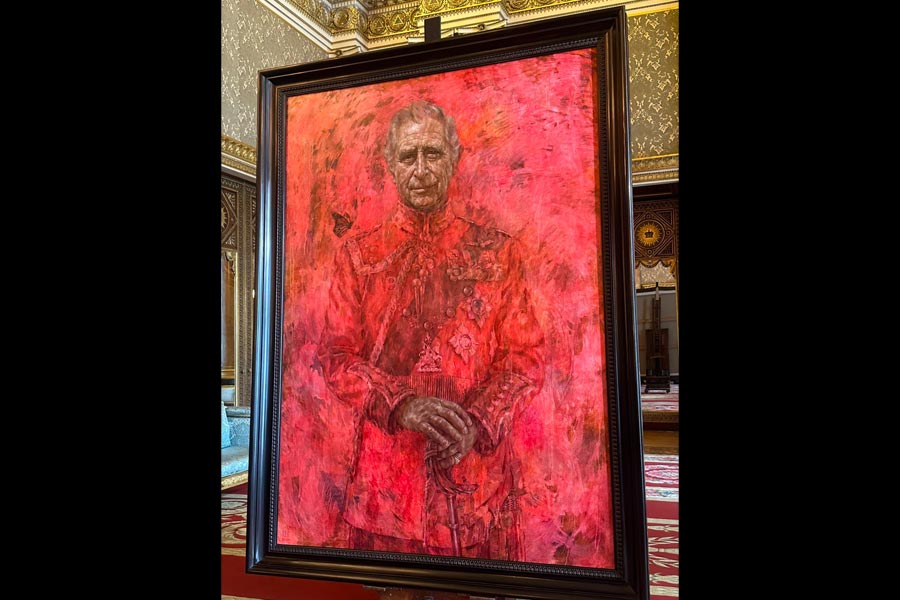Royal portraits, as a rule, tend to be fairly staid, predictable affairs. Full of symbolism, sure, but generally symbolism of the traditional, establishment kind: symbols of state, of office, of pomp and lineage.
Which is why the new official portrait of King Charles III by Jonathan Yeo, the first since the king’s coronation, has created such a controversy.
A larger-than-life (7.5 feet by 5.5 feet) canvas, the portrait shows the king standing in his Welsh Guards uniform, hands on the hilt of his sword, a half-smile on his face, with a butterfly hovering just over his right shoulder. His entire body is bathed in a sea of crimson, so his face appears to be floating.
Although the butterfly was apparently the key piece of semiology — meant, Yeo told the BBC, to represent Charles’ metamorphosis from prince to sovereign and his long-standing love of the environment — it was the painting’s primary color that almost instantaneously gave new meaning to the idea of “seeing red.” It was practically begging for interpretation.
“To me it gives the message the monarchy is going up in flames or the king is burning in hell,” one commentator wrote under the royal family’s Instagram post when the portrait was unveiled.
“It looks like he’s bathing in blood,” another wrote. Someone else raised the idea of “colonial bloodshed.” There were comparisons to the devil. And so on. There was even a mention of the Tampax affair, a reference to an infamous comment by Charles revealed when his phone was hacked during the demise of his marriage to Diana, Princess of Wales.
It turns out that red is a trigger color for almost everyone — especially given the somewhat meta endeavor that is royal portraiture: a representation of a representation, made for posterity.
In his interview with the BBC, Yeo noted that when the king first saw the painting, he was “initially mildly surprised by the strong color,” which may be an understatement. Yeo said his goal was to produce a more modern royal portrait, reflecting Charles’ desire to be a more modern monarch, reducing the number of working royals and scaling back the pageantry of the coronation (all things being relative).
Still, the choice of shade seems particularly fraught given the … well, firestorm the king has endured since his ascension to the throne.
Consider, for example, the continued falling out with his second son, Prince Harry, and the publication of Harry’s memoir, with its allegations of royal racism; the related calls for an end to the monarchy; Charles’ cancer diagnosis; and the furor over the mystery about Catherine, Princess of Wales, whose own cancer diagnosis was revealed only after increasingly unhinged speculation about her disappearance from public life.
Queen Camilla, who has been through her own ring of flames, reportedly told the artist, “You’ve got him.”
It’s hard to imagine Yeo didn’t anticipate some of the reaction to the portrait, especially in the context of his past work, including portraits of Prince Philip, the king’s father, and Camilla, which are more traditional depictions. Indeed, the last time a royal portraitist attempted a more abstract, contemporary interpretation of their subject — a 1998 portrait of Queen Elizabeth II by Justin Mortimer, which depicted the queen against a neon yellow background with a splash of yellow bisecting her neck — it produced a similar public outcry. The Daily Mail accused the artist of cutting off the queen’s head.
The portrait of Charles will remain on display at the Philip Mould Gallery until mid-June, when it will move to Drapers’ Hall in London. (It was commissioned by the Worshipful Company of Drapers, a medieval guild turned philanthropy, to reside among hundreds of other, more orthodox royal portraits.)
In that setting, Yeo’s work may be especially telling: reflective of not just a monarch, but also the evolution of the role itself, the conflicts around the job and a king captured forevermore in what very much looks like the hot seat.
The New York Times News Service











